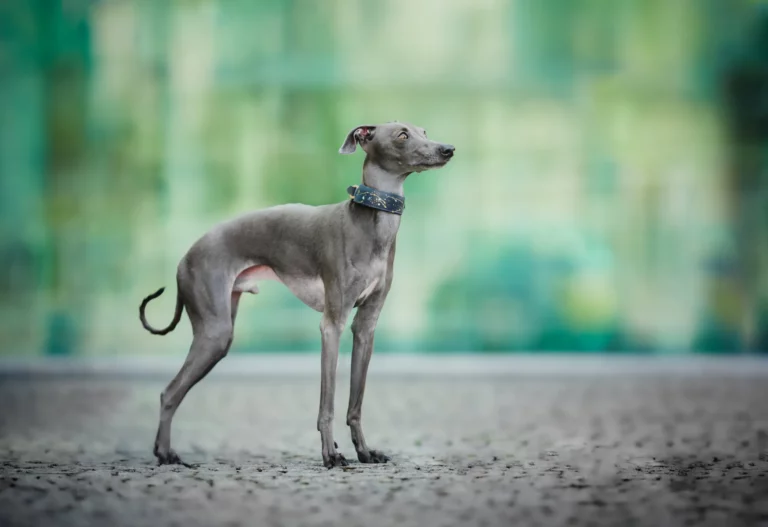Italian Greyhound Dog Breed
The Italian Greyhound is a breed that exudes elegance and agility, with a history that stretches back to ancient times. Known for being the tiniest member of the sighthound family, these dogs are identifiable by their smooth coats, distinctive prancing walk, and a personality that combines a cozy friendliness with lively smarts.
They were once the darlings of high society, admired for their stylish looks and loving nature, and they still win the hearts of dog lovers today. Yet, despite their delicate appearance, Italian Greyhounds are surprisingly resilient and come with a set of care needs that should be thoughtfully considered by anyone thinking of getting one.
In discussing this breed’s health, behavior, and upkeep, it becomes clear why the Italian Greyhound has remained a cherished companion over thousands of years and what that means for modern-day dog owners.
Italian Greyhounds have a legacy that influences how we care for them today. Understanding their health and temperament is vital for a happy life with these graceful pets. They thrive with consistent attention and proper training, which helps them exhibit their natural affection and intelligence.
Despite their ancient roots, the needs of Italian Greyhounds align well with contemporary life, provided owners are attentive and informed. The ongoing appeal of these dogs lies in their ability to form deep bonds and their adaptability as companions and athletes, ensuring their place in the hearts of those who appreciate their unique blend of historic charm and modern-day versatility.
Key Takeaways
- Italian Greyhounds are ancient, nimble, and sociable.
- Proper care ensures their longstanding companionship.
- They adapt well to modern lifestyles with attentive owners.
The Italian Greyhound stands out for its elegance and agility, tracing back to antiquity. Most miniature sighthound dogs sport smooth coats and a unique prance. They blend cozy friendliness with spirited intelligence.
Once favored by aristocrats for their stylish looks and affectionate demeanor, they continue to charm dog enthusiasts. Despite their fragile look, Italian Greyhounds possess a surprising toughness, with specific care requirements.
Understanding their health and temperament is crucial for a fulfilling life with these graceful animals. They flourish with regular attention and proper training, showcasing their innate love and cleverness.
Italian Greyhounds match well with current-day life when their human companions are engaged and well-informed. Their enduring popularity stems from their deep connections and versatility, securing their status among those who value a blend of historical allure and present-day adaptability.
Quick Facts
The Italian Greyhound is a charming toy breed that typically weighs between 7 and 14 pounds and reaches a height of around 13 to 15 inches at the shoulder. These dogs have a lifespan of about 14 to 15 years. This breed is a smaller version of the traditional Greyhound and is known for its slim figure and refined appearance that makes it a perfect companion. Italian Greyhounds have a sleek body and thin legs that allow them to run up to 60 km/h in quick dashes.
This breed combines strength with a particular delicacy. Their thin bones and lean muscles mean they don’t need a lot of exercise – about 20 minutes a day is enough. Their short and smooth coat is low-maintenance, requiring regular brushing to stay shiny.
Italian Greyhounds are sweet but can be sensitive, so they benefit from patient and consistent training. They usually get along well with children and other pets, which makes them adaptable to different home environments. However, they need careful handling to prevent injuries, and maintaining their dental health is essential for their long-term well-being.
Italian Greyhound Dog Breed Pictures
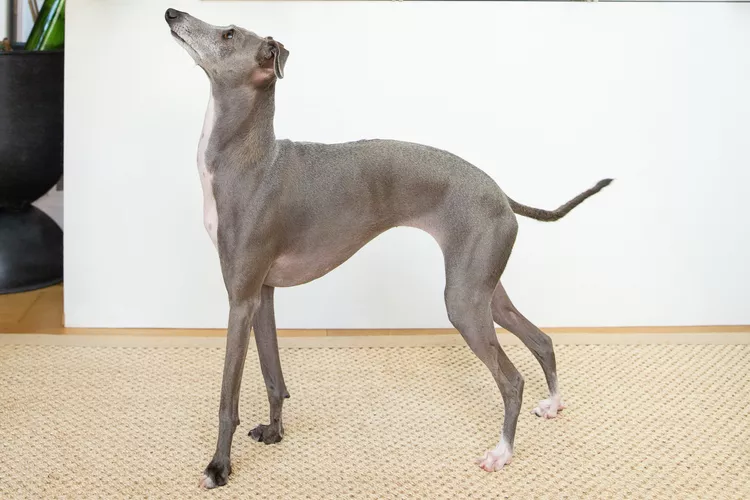
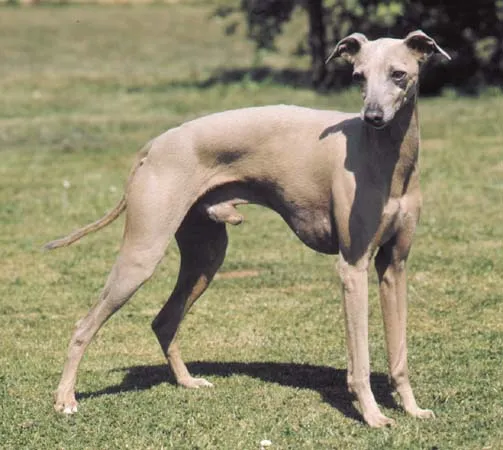
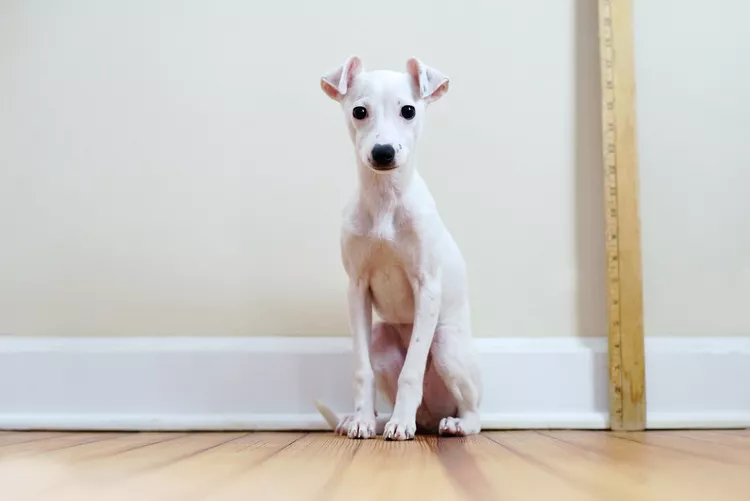
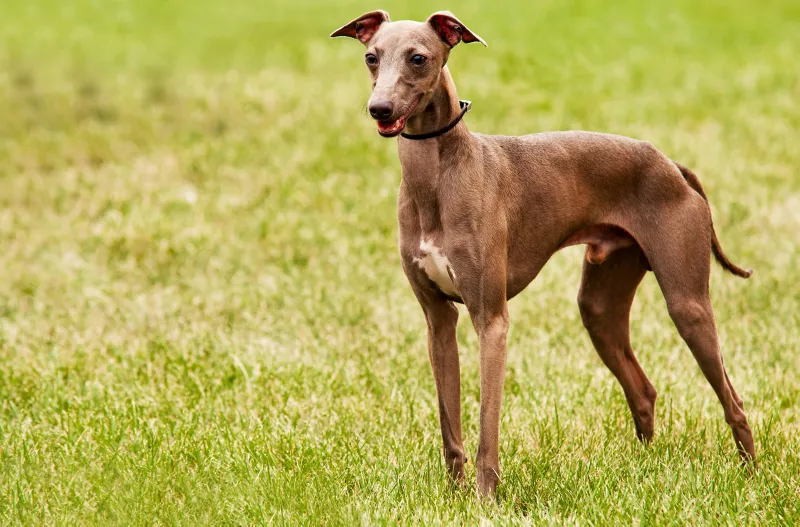
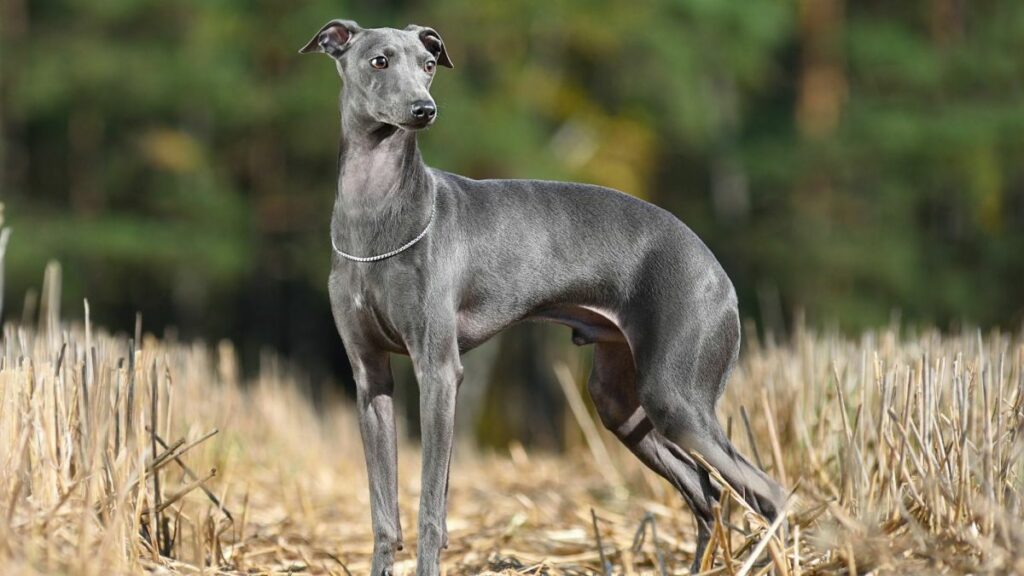
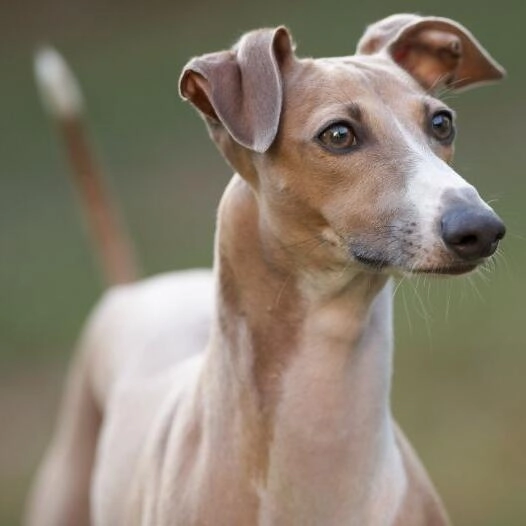
Overview
Italian Greyhounds embody sophistication in a small dog, blending their larger cousins’ elegance with a temperament perfect for pet owners and apartment living. They stand proud at the shoulder at 13 to 15 inches tall and tip the scales at a mere 7 to 14 pounds. These petite sighthounds offer city residents the perfect mix of compact size and lively spirit. They also boast a commendable lifespan of about 14 to 15 years, demonstrating their hardiness despite their delicate looks.
Regarding personality, Italian Greyhounds are known for their warmhearted nature, quickly becoming loving partners to their owners. Their calm temperament makes them ideal for home settings, especially smaller apartments. Their slender, short coat is another plus, making grooming a breeze with just some regular brushing and the occasional bath to keep their fur shiny.
Italian Greyhounds are bright, which makes them quite teachable, but they have a bit of a willful side. This means training them requires a gentle hand and steady guidance. These small dogs have a surprising amount of energy and need daily exercise to stay fit and happy. They aren’t fans of bad weather, so sometimes you might need to give them a little nudge to get outside when the weather turns sour.
Breed Distinctive Features
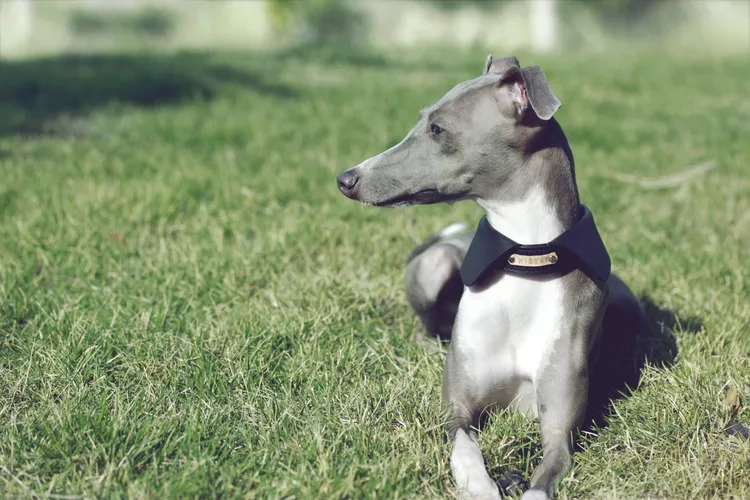
Italian Greyhounds are known for their sleek and athletic build, combining beauty and function. Their slender yet strong body allows them to run fast and make impressive jumps. These dogs are the smallest of the sighthounds, standing between 13 and 15 inches tall. Their bodies are slender and muscular, with a distinctive curved back.
The legs and tail of an Italian Greyhound are lean and elegant, with the tail curving gracefully. Their head is long and narrow with a refined muzzle, while their ears are small and fold back gently. Italian Greyhounds have smooth coats in various colors, but you won’t find brindle, black, or tan among them. These dogs are not just beautiful; they are also known for being affectionate and forming strong bonds with their owners. Giving them plenty of love and attention is essential to prevent unwanted behaviors.
Here’s a simple table highlighting the Italian Greyhound’s key features:
| Feature | Description |
|---|---|
| Size | Legs are lean, and the tail tapers into a curve |
| Body | A slender, muscular build with a signature curved back |
| Legs & Tail | Legs are lean, and the tail tapers into a curve |
| Head & Muzzle | They have a long, narrow head with a fine muzzle |
| Ears | Their ears are small and fold back |
Italian Greyhounds excel in combining graceful aesthetics with dynamic physical abilities. They exemplify a perfect blend of form and function in the canine world.
Ancient Lineage Origins
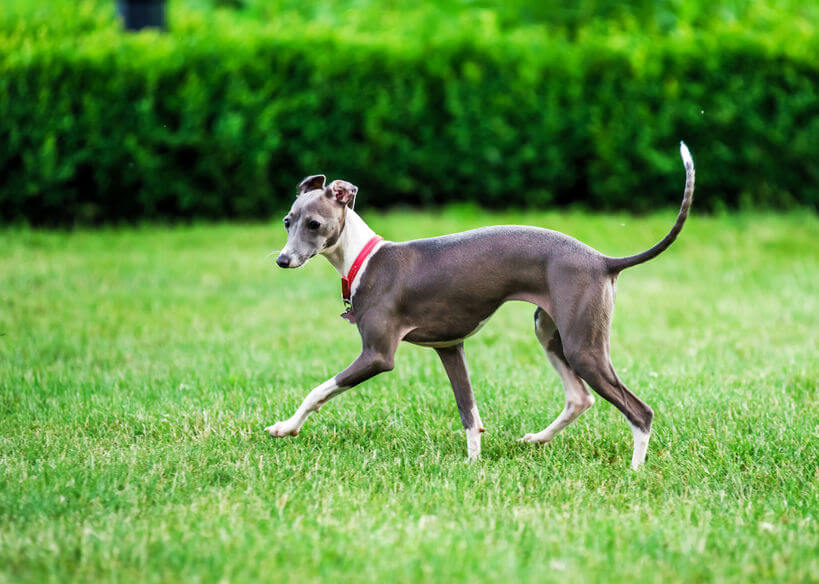
The Italian Greyhound has a storied past, tracing its lineage to ancient societies that held dogs in high regard. This breed has consistently been a part of the upper class, often shown in artwork and writings as an emblem of luxury and prestige. Its development over time has been influenced by its hunting capabilities and its association with aristocracy.
- Breed Ancestral Roots
- It originated from areas skilled in taming animals.
- She was known to be in homes of Egyptian and Mediterranean nobility.
- Historic Significance
- Italian and French monarchs favored this breed.
- It is frequently featured in historical art, indicating its high regard.
- Evolution Over Centuries
- Adapted for effective hunting.
- Physical changes are steered by the high society’s taste for beauty.
The Italian Greyhound is known for its long heritage, which began among early civilizations celebrating their canine friends. This breed has been a constant symbol of sophistication, gracing the lives of the elite and often being captured in cultural works as a sign of wealth. Over the years, the Italian Greyhound has evolved, with a keen focus on hunting prowess and meeting the aesthetic demands of the well-to-do.
- Breed Ancestral Roots
- It was hailing from places that excelled in domesticating animals.
- A familiar presence in the opulent dwellings of Egypt and around the Mediterranean Sea.
- Historic Significance
- Esteemed by the rulers of Italy and France.
- Art and literature throughout history have celebrated their revered status.
- Evolution Over Centuries
- Developed specialized hunting skills.
- The preferences of the societal elite shape physical appearance.
Breed Ancestral Roots
Italian Greyhounds have a long and noble history, dating back to ancient times. They were once the cherished pets of royalty across the Mediterranean, with their heritage traceable to Ancient Egypt. These small sighthounds were celebrated in artworks, serving as a testament to their high regard in society. During the Middle Ages, they were particularly beloved by Italian noblewomen, highlighting their enduring connection with the upper class.
These dogs are not just known for their elegance but also their skill in hunting. Their history is rich with tales of companionship and utility within human societies. They are a testament to the blend of aesthetic appeal and practical ability valued throughout the ages.
Historic Significance
The Italian Greyhound has a long history that dates back to ancient civilizations. The nobility highly regarded this dog breed, and has been found in Egyptian tombs. Considered both elegant and noble, Italian Greyhounds were often seen in European royal courts, favored by figures like Catherine the Great and Anne of Denmark. Their images are familiar in historical artworks, highlighting their importance through time.
These dogs were decorative and skilled in hunting small game such as hares and rabbits, making them valuable to their owners. In the UK during the 19th century, the Italian Greyhound Club was formed to ensure the breed’s survival and maintain its esteemed heritage.
Evolution Over Centuries
The Italian Greyhound has a rich history that dates back over 2,000 years. Originating from small sighthounds in Greece and Turkey, these dogs are often depicted in ancient Mediterranean artwork, which showcases their consistent breed appearance throughout history.
In the Middle Ages, the breed underwent significant refinement due to selective breeding by humans. This era was pivotal for the Italian Greyhound, as it became a beloved pet, a symbol of nobility, and an adept hunter. The breed was shaped by the aesthetic preferences and practical needs of those times, leading to its signature lean build, graceful movement, and sophisticated presence—traits that have persisted through the ages.
Slim Build Profile
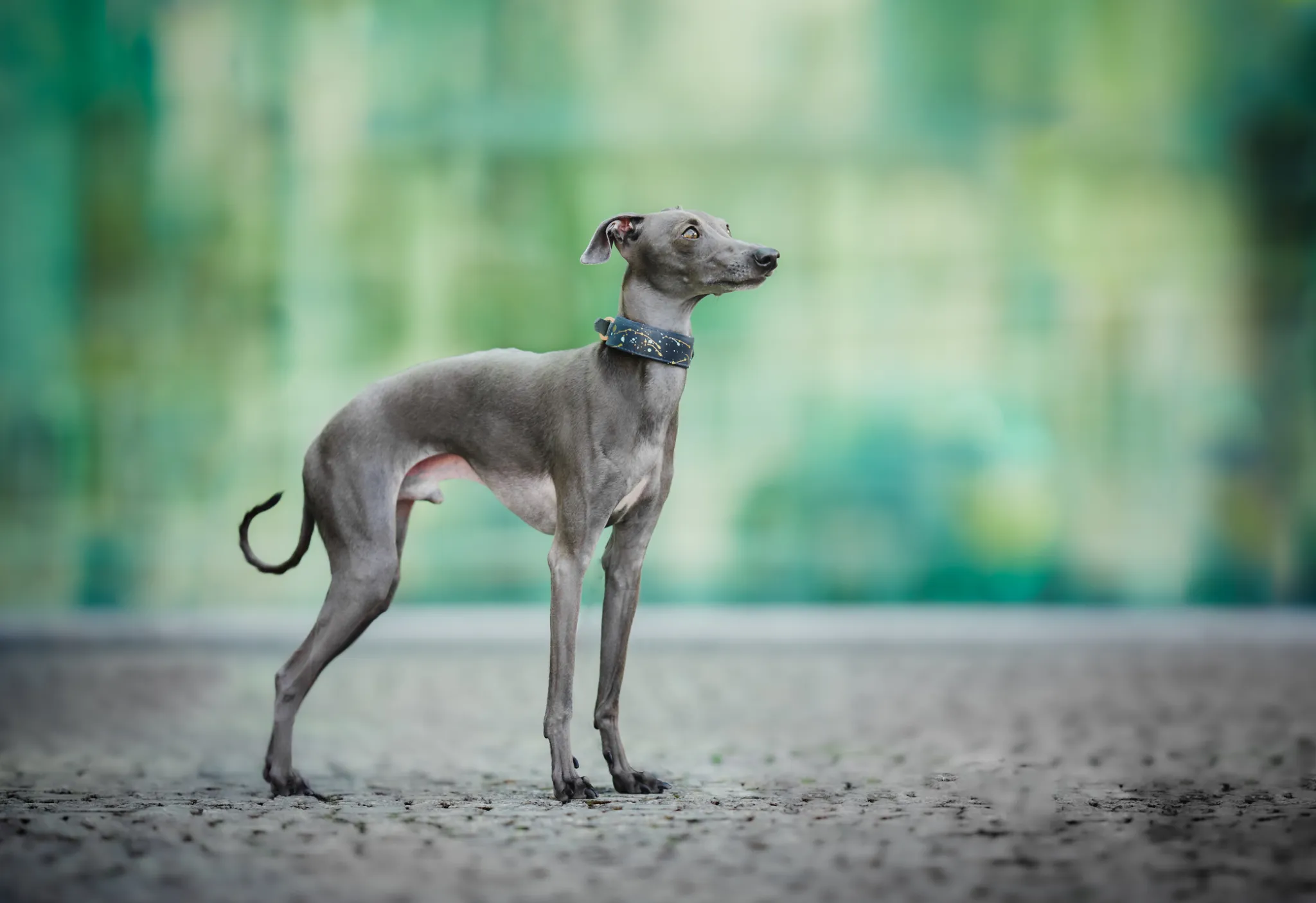
The Italian Greyhound boasts a slender frame that’s more than just appealing to the eye; it’s a clever adaptation shaped by nature to boost their speed and quickness. With a noticeable difference between the waist and chest sizes and minimal body fat, this sleek form helps these dogs rush with sudden acceleration.
In terms of athletic prowess, a narrow build means less wind resistance and the ability to take longer strides. This is crucial for the Italian Greyhound’s performance in races and agility courses. Their lean muscles play a vital part in allowing these dogs to move swiftly and quickly change directions.
Regarding their health, the breed’s slender bone structure may predispose them to specific joint issues. That’s why it’s critical to monitor their diet closely. A balanced diet keeps them in top condition without missing essential nutrients.
While elegant, their build means they can be more prone to injuries. Owners should ensure a safe environment for these dogs to exercise without unnecessary risks. Regular vet check-ups are also essential to monitor their skeletal health.
Defining Slim Build
Italian Greyhounds are known for their svelte figures, marked by their long, slender bodies and distinctive arched spines. Their deep chests and slim legs give them an elegant appearance, while their lightweight, fine-boned skeletons make them look almost fragile. These dogs move with a gracefulness that speaks to their agility and speed, traits that Italian Greyhounds are famous for. Their thin tails taper gracefully, matching the sleek lines of their physique.
The head of an Italian Greyhound is elongated with a sharp muzzle, and their ears are small and delicate, contributing to their overall dainty appearance. Their short and glossy coats fit snugly against their body, showcasing their toned muscles. These dogs typically weigh between 7 and 14 pounds, making them the perfect example of a slim build in the canine world.
Athleticism and Speed
The Italian Greyhound, known for its sleek physique, excels in speed and agility. Their slender body, a blend of delicate bones and well-defined muscles, perfectly suits fast movement. They have large chests that provide ample space for their lungs, which is essential for breathing during quick runs. Long legs enable these dogs to cover more ground per stride. Although they are lightweight, typically tipping the scales at 7-14 pounds, Italian Greyhounds have impressive stamina. This makes them well-suited for dog sports that test their swiftness and endurance.
Keeping these active dogs in top shape with regular exercise, about 20 minutes each day, is crucial. This helps maintain their physical health and keeps them from becoming too restless. Italian Greyhounds are known for their vibrant and playful personalities. They make great partners for people who enjoy an active lifestyle and are looking for a spirited and quick dog.
Health Considerations
With their slender frames, Italian Greyhounds need extra care to avoid injuries and stay healthy. Their thin bones can easily break, so watching them closely during activities is essential. These dogs often have tooth problems, so keeping up with their dental care is necessary. Skin allergies are another concern, so regular check-ups with a vet for their skin health are required.
These dogs don’t like the cold, so keeping them warm when it turns chilly is smart. They may not want to go outside, but protecting them from the elements is essential. Training and helping them to get used to people and other animals can help prevent behavior issues like nervousness or shyness. Regular vet visits are crucial to keep these elegant dogs in good shape.
Dietary Management
Italian Greyhounds, known for their sleek physique, thrive on a diet filled with premium proteins to keep their energy high. Their slender build requires a balanced diet to prevent health issues. Monitoring their food portions is critical to stop them from losing too much weight, which their fragile bodies can’t handle.
Including healthy fats, like omega-3s, are essential for their skin and coat and general health. Sticking to a regular feeding schedule and watching treats helps control their calorie intake and reduces the risk of obesity.
Plus, they must have plenty of fresh water to stay adequately hydrated, which is a big part of their diet and health.
Italian Greyhounds need a balanced diet and portion control to stay healthy. Healthy fats and omega-3 fatty acids are essential for their coat and overall health. Regular meals and limited treats will help avoid weight problems. They also need constant access to fresh water for good hydration.
Clothing and Warmth
Proper nutrition is crucial for an Italian Greyhound’s health, but it’s just as necessary to consider their need for warmth due to their thin physique and low body fat. These dogs have little to keep them warm, so they must have the right clothes when the temperature drops.
Choosing clothing that fits snugly but doesn’t restrict their movement is smart. Look for dog sweaters and coats made of materials that keep the heat in while still comfortable.
Watch your Italian Greyhound closely when dressed up to ensure they’re not stressed or uncomfortable. If they’re unhappy, it could be because the clothes don’t fit or they don’t like wearing them.
Keep an eye on how warm or cool they are inside the house, and change their clothing as needed to ensure they stay cozy.
Temperament Traits
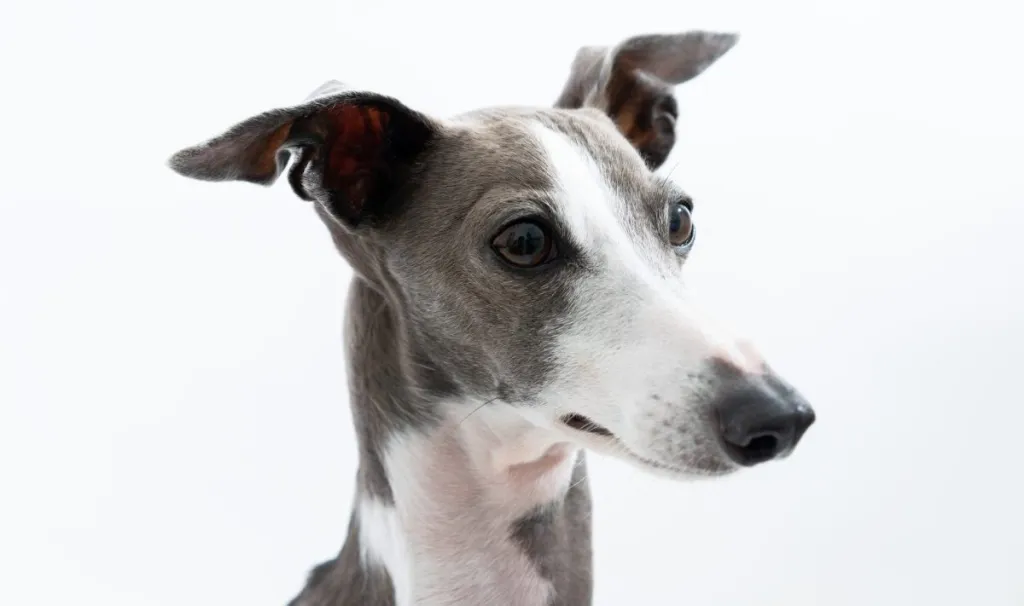
Italian Greyhounds are known for their loyal and loving nature, often forming deep bonds with their families. This breed thrives on companionship, making them great pets for those who can spend much time with them. However, they might struggle with being alone and could develop anxiety if left by themselves for too long.
These dogs have a lively and playful spirit, enjoying quick sprints that showcase their agility. They don’t need excessive exercise but do require regular activity to stay happy and healthy. Their small stature makes them ideal for moderate exercise routines.
Italian Greyhounds are pretty sensitive to their surroundings and the emotions of their human companions. They sometimes act nervously around loud sounds or in new settings, so patience and gentleness are essential.
Socializing Italian Greyhounds early on is beneficial. It helps them become more confident around new people and other animals. Introduce them carefully to different situations and pets to ensure they become well-adjusted adults.
Regarding training, Italian Greyhounds are intelligent and learn quickly but might show a stubborn streak. Positive reinforcement is the best way to train them because of their sensitivity. This approach is kinder and more effective, leading to better learning outcomes.
Affectionate Companion Nature
Italian Greyhounds are known for their loving nature and make ideal pets for those seeking a close bond with their dog.
These dogs crave interaction and enjoy snuggling with their owners, highlighting their need for a solid emotional connection. They are friendly with kids and other animals but can become anxious or agitated if they don’t receive enough attention.
Italian Greyhounds form deep attachments, often becoming dedicated to one person or a single household. Their love for being cozy and comfortable makes them treasured family members.
Energetic Playful Behavior
Italian Greyhounds are known for their loving nature and dynamic personalities. They love to play and often break into joyful runs, showing their impressive speed and agility. These dogs need regular exercise to keep up with their energy and to stay healthy, both in body and mind. Italian Greyhounds like cozy, warm spaces and enjoy spending time with their humans.
Training these dogs works best with positive feedback since they respond well to praise. They thrive in environments that provide plenty of activities and company. These dogs love staying active and cuddling up with their favorite people throughout the day.
Sensitivity Levels
Italian Greyhounds are known for their emotional sensitivity, which makes them highly attuned to the feelings around them. This means they thrive best with patient training and a calm home environment. These dogs need a lot of companionship and do best when they’re not left alone for long periods. They’re naturally gentle and loving but can become skittish in noisy or unpredictable situations.
It is crucial to provide Italian Greyhounds with consistent socialization and regular affection for their well-being. Without it, they may become shy or overly energetic. Use positive reinforcement when training them to align with their sensitivities. They might not be the best fit for families with very young children due to their need for a tranquil environment.
Social Interaction Needs
Italian Greyhounds are known for their emotional sensitivity. It’s essential to meet their social needs for their happiness and health. These slim dogs are happiest with company, and being alone can cause them stress. They love and make great family pets, play nicely with kids, and live peacefully with others. Even though they like to chase, they can adjust well to living in various homes, including apartments.
However, their brains need to stay busy. Italian Greyhounds benefit from regular mental exercises and respond well to positive training methods, helping them overcome their sometimes stubborn behavior. If they don’t get enough attention and brain games, they might become shy or overly active, which can change their friendly nature.
Training and Intelligence
Training Italian Greyhounds can be pretty rewarding, as they are naturally bright. However, their occasional stubborn streak means you’ll need patience and consistency. Training methods involving many brain games and rewards often work well with these dogs. They are sweet, loving, and susceptible, so creating an encouraging training space that doesn’t involve scolding is essential.
Italian Greyhounds need company and can get very anxious if left alone too much. Including training in your daily play and interaction helps them listen better and strengthens your bond. These dogs can do well in many different living situations if their emotional and mental well-being is considered.
In training Italian Greyhounds, it’s valuable to remember their sociability and aversion to loneliness. Implementing short, engaging training sessions throughout the day can make a big difference. This keeps their minds active and helps prevent their distress when separated from their owners. With their adaptable nature, these dogs can thrive in obedience training in various settings as long as their need for affection and mental engagement is fulfilled.
Common Health Concerns
Italian Greyhounds have their health challenges that owners must watch out for. They have a genetic tendency to develop periodontal disease, so it’s vital to keep up with their dental care through regular brushing and vet visits to avoid any serious issues.
Health Concerns to Watch For
- Heart Health: It’s wise to get their hearts checked regularly to catch any early signs of heart problems.
- Bone Health: Being aware of any unusual symptoms can help catch bone diseases early, which are common in this breed.
Dental Health
- Brushing Teeth: Making teeth brushing a daily habit can significantly lower the chance of dental problems.
- Veterinary Check-ups: Getting their teeth checked by a vet once a year is a good practice to prevent serious dental issues.
Preventive Health
- Diet and Exercise: Keeping them on a healthy diet and ensuring enough exercise is crucial to keeping them fit and avoiding weight issues.
- Safe Environment: Removing any dangers from their living area to prevent injuries is essential, as their slender bodies are fragile.
Genetic Health Issues
Italian Greyhounds face several health challenges. They need regular dental care to avoid gum disease, which could lead to more severe health problems. Their thin coats make them prone to skin issues, so managing their environment and diet is essential to prevent allergies.
These dogs are also more likely to break bones due to their slim build, so owners must be cautious to avoid accidents. Although hip dysplasia is rarer in Italian Greyhounds than in larger breeds, careful breeding is still necessary to reduce the chances of this painful joint condition.
This attention to health helps ensure a robust future for these elegant dogs.
Dental Care Importance
Taking care of an Italian Greyhound’s teeth is crucial for their health. These dogs tend to have more dental issues, so owners must be proactive about oral care. Regular brushing of their teeth and veterinary check-ups that include a look at their mouth can catch problems early. Without these steps, dental problems can lead to pain, trouble eating, and other health issues.
Making dental care a regular part of an Italian Greyhound’s routine is essential. Providing chew toys that help clean their teeth can also keep their mouth healthy. This helps to reduce the chance of dental diseases in these elegant dogs.
Preventive Health Measures
Dental care is crucial for an Italian Greyhound’s health. Regular vet visits are necessary to catch and treat any health problems early. Protecting these dogs from very cold or hot weather is critical because they have thin coats and little body fat, which puts them at risk for hypothermia or heatstroke. Their delicate frame means they need a safe environment to avoid getting hurt. It’s also important to watch them around small children to prevent accidents. For Italian Greyhounds with skin allergies, getting advice from a vet is vital to keeping their skin healthy and avoiding further issues that can affect their comfort and quality of life.
Grooming Essentials
Caring for an Italian Greyhound involves steps that ensure the pet’s health and comfort. Regular grooming is more than just keeping the dog looking good; it’s also about maintaining physical health. Let’s go over essential grooming routines for an Italian Greyhound.
Coat Care is simple for this breed. Their short hair requires brushing only a few times weekly to minimize shedding and keep their skin healthy. Use dog-specific shampoos and conditioners to keep their coat shiny.
For Nail Trimming, it’s best to clip their nails every few weeks to avoid discomfort when walking. Use a dog nail clipper and avoid the quick, which can cause pain if cut.
Maintaining Dental Health is vital. Brushing your dog’s teeth several times a week prevents gum disease and tooth decay. You can also give them dental chews to help keep their teeth clean.
Ear Care is also essential. Check your dog’s ears regularly for dirt or signs of infection. Clean their ears gently with a vet-approved solution and a cotton ball.
When it comes to Bathing, do it as needed — usually not more than once a month. Over-bathing can strip their skin of natural oils. Always opt for gentle, hypoallergenic products to prevent irritation.
Coat Care Routine
Caring for an Italian Greyhound’s coat is pretty simple and doesn’t require much time. Regular brushing helps keep their short fur in good condition and minimizes shedding. They don’t need frequent baths, but when they do, it’s best to use a mild shampoo made for dogs.
It’s essential to keep an eye on their ears to prevent wax build-up and infections; cleaning them should be part of the routine. Their nails need cutting every other week to stop them from getting too long, which can cause discomfort. Use appropriate dog nail clippers for this task.
Oral health is also vital for these dogs. Brushing their teeth regularly with toothpaste designed for dogs and a soft toothbrush will help avoid dental problems.
Nail Trimming Frequency
Proper care for an Italian Greyhound includes routine nail trimming to keep them comfortable. Aim to trim their nails every 2-4 weeks to avoid overgrowth that can lead to discomfort or injury. When nails grow too long, they can split, crack, or become ingrown, causing pain for your dog.
Trimming nails with caution is vital to prevent cutting into the nail’s blood supply. Cutting the short can be painful and cause bleeding. If you’re not confident doing it yourself, consider taking your Italian Greyhound to a professional groomer.
To make the process smoother, use positive reinforcement to get your dog used to nail trimming, reducing their stress and making them more willing participants.
Dental Hygiene Tips
Taking good care of your Italian Greyhound’s teeth is vital to their health. Brush their teeth every day with toothpaste that’s safe for dogs and a soft toothbrush to stop plaque and tartar from building up. This also helps prevent gum disease. Giving your dog chew toys that are made to keep their teeth clean can also help keep their mouth healthy. It’s like giving their teeth a mini workout!
Regular check-ups at the vet are essential to catch any teeth or gum problems early, like bad breath, red gums, or if they seem to have trouble chewing. If you notice these signs, get them to the vet quickly to keep your dog healthy and happy.
Ear Cleaning Guide
Regular ear care is vital for your Italian Greyhound’s health, helping to ward off infections. Choose a vet-recommended ear cleaner designed for dogs with delicate ears. When cleaning, softly wipe the external parts of the ear with a cotton ball or pad, but don’t put anything deep into the ear canal to avoid harm. Keep an eye out for signs of infection like redness, swelling, or bad smell, and get your dog to a vet if you notice any. Be gentle when handling your dog’s ears, and use treats and praise to make the process more pleasant. Consistent checks and cleanings are vital to keeping your Italian Greyhound’s ears healthy.
Ensure your dog’s ears stay healthy by keeping up with routine cleanings. Use a gentle ear-cleaning solution safe for dogs, and clean only the parts of the ear you can see with a cotton ball or soft cloth. Stay alert for any symptoms of ear problems, such as redness or a foul smell, and talk to a vet if they come up. Treat your dog kindly during ear cleaning, offering treats and praise to help it stay calm. Regular ear care, including cleanings and check-ups, is crucial for breeds like the Italian Greyhound.
Bathing Best Practices
Proper grooming for an Italian Greyhound involves a thoughtful approach to Bathing, considering how frequently you wash them, what kind of shampoo you use, and the techniques that best suit their delicate skin and coat.
Since their skin can be sensitive and they have a thin coat, it’s essential to avoid irritation. Bathing them once a month usually works well, but this can change depending on how active they are and the environment they’re in. Choose a gentle, hypoallergenic dog shampoo to keep their skin’s natural oils balanced and prevent any skin problems.
When washing your Italian Greyhound, use a soft touch to massage their skin, which promotes good blood flow and cleans them effectively. Make sure to rinse them thoroughly to get rid of any shampoo residue.
After the bath, pat them dry with a soft towel or use a low-heat hairdryer, taking care not to overheat or chill them, especially since they don’t have much body fat to keep them warm.
Breeder of Italian Greyhound Puppies Dietary Requirements
Italian Greyhounds require a diet that supports their unique physical traits and high energy demands. It’s crucial to provide them with a diet that promotes optimal health, incorporating all the necessary nutrients in the right amounts. Their diet must include:
- Nutritional Balance: Provide a mix of proteins, carbohydrates, and fats to support their health.
- Quality Protein: Include good protein sources to help maintain strong muscles.
- Carbohydrate Intake: Ensure they get enough carbs to fuel their high energy levels.
When it comes to feeding these dogs, it’s essential to establish a routine:
- Regular Meal Times: Consistency in feeding supports their fast metabolism.
- Portion Size: Careful monitoring of food amounts helps prevent obesity.
For their specific dietary needs, consider the following:
- Vitamins and Minerals: Add supplements to their diet based on a vet’s advice.
- Dietary Adjustments: Modify their food intake based on age, activity, and any health conditions they might have.
Feeding Italian Greyhounds a diet as active and vibrant as they are is essential. By understanding their needs and adjusting their food intake according to the American Kennel Club, you can keep your Italian Greyhound healthy and happy.
Balanced Nutritional Needs
Italian Greyhounds need a protein-rich diet with healthy fats to maintain their active lifestyle. Their meals should also include the right vitamins and minerals.
Breeder should measure their food correctly, which is crucial to prevent weight gain, which can cause health issues. Checking in with a vet regularly helps customize their meals based on age, activity, and any health problems they might have.
Keeping water available at all times is essential for these energetic dogs. Following these nutrition tips helps keep Italian Greyhounds healthy and happy.
Feeding Schedule Guidelines
Small and regular meals are crucial for Italian Greyhounds to keep up their fast metabolism and avoid low blood sugar. Their diet should be full of high-quality protein to support their muscles, and they need healthy fats for long-lasting energy.
For Italian Greyhound puppies, a specialized diet for small breeds ensures they get all the necessary nutrients for growth.
Keeping an eye on their weight and adjusting food amounts is critical to preventing obesity, which is often a concern for these dogs.
Working with a vet, you can create a feeding plan that suits your dog’s unique needs, considering their age, how active they are, and any special dietary needs.
Special Diet Considerations
For Italian Greyhounds, choosing a quality diet that supports their active lifestyle and small size is crucial. Their meals should be well-portioned to prevent weight gain, which they’re prone to. These dogs do well with multiple small meals throughout the day to keep their blood sugar stable and avoid low blood sugar levels.
Since Italian Greyhounds can have sensitive stomachs, it’s wise to introduce new foods slowly to watch for any digestive issues. Always talk with your vet to ensure your dog’s diet meets their unique needs and pinpoint any food sensitivities.
This approach will help keep your Italian Greyhound healthy and full of energy.

